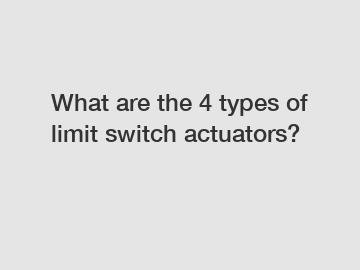What are the 4 types of limit switch actuators?
What are the 4 types of limit switch actuators?
Limit switches are versatile devices used in various industries to detect the presence or absence of an object and control the operation of machinery. They rely on actuators, which are mechanical devices responsible for triggering the switch when a specific physical motion occurs. There are four common types of limit switch actuators - lever, roller, plunger, and whisker. In this article, we will explore each type and their applications in different industries.
Lever:

Lever actuators are the most commonly used type of limit switch actuator. They consist of a lever arm attached to the switch mechanism. When the lever arm is pushed or pulled, it activates the switch, signaling the desired action. Lever actuators are versatile and can be used in various applications, including door and gate control, conveyor systems, and packaging machinery. They are available in different lengths and configurations to accommodate different needs.
Roller:
Roller actuators feature a wheel or roller attached to the switch mechanism. When the object comes in contact with the roller, it rolls or pivots, causing the switch to activate. Roller actuators are ideal for detecting objects moving along a specified path or detecting the presence of irregularly shaped objects. They are commonly used in assembly lines, material handling equipment, and automatic doors. The roller design allows for smooth operation and reduces the risk of false triggering.
Plunger:
Plunger actuators are designed with a spring-loaded plunger that retracts into the switch when pressed. When the object pushes against the plunger, it extends, triggering the switch. This type of actuator is suitable for applications that require precise and immediate detection, such as emergency stop systems, machine tools, and robotic arms. Plunger actuators can be customized with different plunger lengths and spring forces to meet specific requirements.
Whisker:
Whisker actuators, also known as spring-actuated or snap-acting switches, consist of a thin, flexible metal rod that acts as a spring-loaded contact. When the object touches the whisker, it flexes, completing the circuit and activating the switch. Whisker actuators are commonly used in applications where the detection of small or light objects is crucial, such as vending machines, coin-operated equipment, and presence sensing systems. They are sensitive and have a quick response time, making them ideal for precise object detection.
In conclusion, limit switch actuators play a critical role in the functioning of limit switches, allowing for the detection of objects and control of machinery. The four types of limit switch actuators - lever, roller, plunger, and whisker - offer different advantages and are used in various industries depending on the specific application requirements. Understanding the differences between these actuator types can help businesses choose the most suitable option for their needs, ensuring reliable and efficient operation.
If you have any further questions or require assistance with limit switch actuators, feel free to contact us. Our team of experts is ready to provide the guidance and support you need to make informed decisions for your business.
If you want to learn more, please visit our website how many types of limit switch, Small Limit Switch, Wholesale Stainless Steel Roller Limit Switch Supplier.
192
0
0

Comments
All Comments (0)